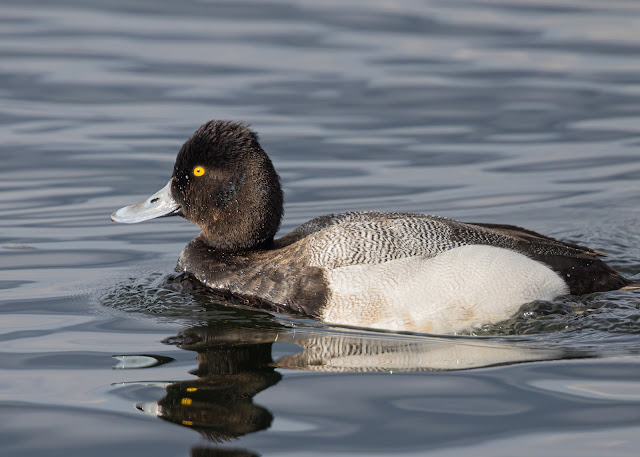 |
| The view from our house over the Malverns early on 6th March |
The heated greenhouse is full of promise with most of the veg started in fibre pots inside. I grow all my flowers for our pots and hanging baskets from seed and cuttings and the heated propagators are full up with rapidly germinating trailing Lobelias, Petunias and Biddens. The first batch of Tomatoes for salad and pasta are also growing strongly.
On Tuesday morning I was planning to process more of the Ash but the weather was much better than forecast so I decided to pop over to one of my old stomping grounds in Oxfordshire, Farmoor reservoir, to see a rare vagrant Lesser Scaup. Come mid-morning I had finished various daily chores on the small holding and checked RBA to see if the bird had been seen but there were no reports. I dropped a message onto the excellent Oxon birders WhatsApp group to see if anyone had seen it. After a short while my friend Ewan responded to say he was at Farmoor but couldn’t find the bird. No problems playing with the log splitter it is then! As we were settling down for lunch Ewan kindly posted another message to say that he had found it on the south side of F2, the larger of the two reservoirs split by a causeway. So after lunch I drove the 50 mile pleasant cross country drive through the Cotswolds to Farmoor. Ewan had said that the Scaup was on the south side of F2 and as I walked around I met another birder who told me it was close to the shore by the bus shelter. There was only a small flock of Tufted Ducks and so it was easy to pick out the distinctive plumage of the Lesser Scaup amongst them.
I’ve only seen 2 Lesser Scaup ; a small North American diving duck that migrates south to central America for winter, in the UK before. The origin of the name scaup is thought to stem from the bird's preference for feeding on scalp—the Scottish word for clams. It is also colloquially known as the Little Bluebill because of its distinctive blue bill. The Farmoor bird is a first winter drake, possibly the same bird as the one on Staines reservoir a few weeks back. It has quite distinctive plumage with a black, iridescent head and a small tuft at the hind crown, a black breast, a whitish-grey back, and wings with darker vermiculations giving it an overall very attractive appearance.
With no one else around I had the bird to myself for an hour or so. It was always in amongst the Tufted Ducks and seemed to be completely accepted by them. I sat quietly on the reservoir perimeter wall and the Lesser Scaup came it very close to feed. As an unexpected bonus the sun came out perfectly positioned behind me for photography. I thought how different this was to my recent experience with a Pallas’s Warbler, see here. Photographing the Lesser Scaup was almost too easy. Rather perversely, I found the cat and mouse game with the Warbler all together much more satisfying when it eventually gave itself up for a few brief minutes.
I got back home just as the full moon was rising over Bredon hill. Low down on the horizon it was a forbidding blood red globe, a phenomena caused by blue light being scattered more than red light by dust in the atmosphere. I like the old pagan names for our full moons, they are so full of character and menace reflecting the superstitions and beliefs of the time. The march moon is called the Storm Moon. Quite appropriate to the weather the next morning when I drew the curtains to be greeted by a snowstorm.
 |
| The Storm Moon rising over Pirton Footnote – my blogs are posted with sometimes rather imaginative spelling and grammar due to my extreme dyslexia! |






Good stuff Jim!
ReplyDeleteCheers Nick!
DeleteWe were walking up there on Sunday Jim, got chatting to a group of birders watching these. Apparently only the second time they have been spotted in Oxon?
ReplyDeleteHi Ian, yes I think that's true - glad you saw it!!
ReplyDelete